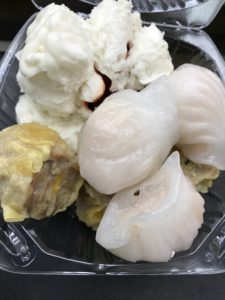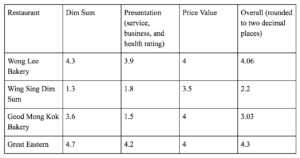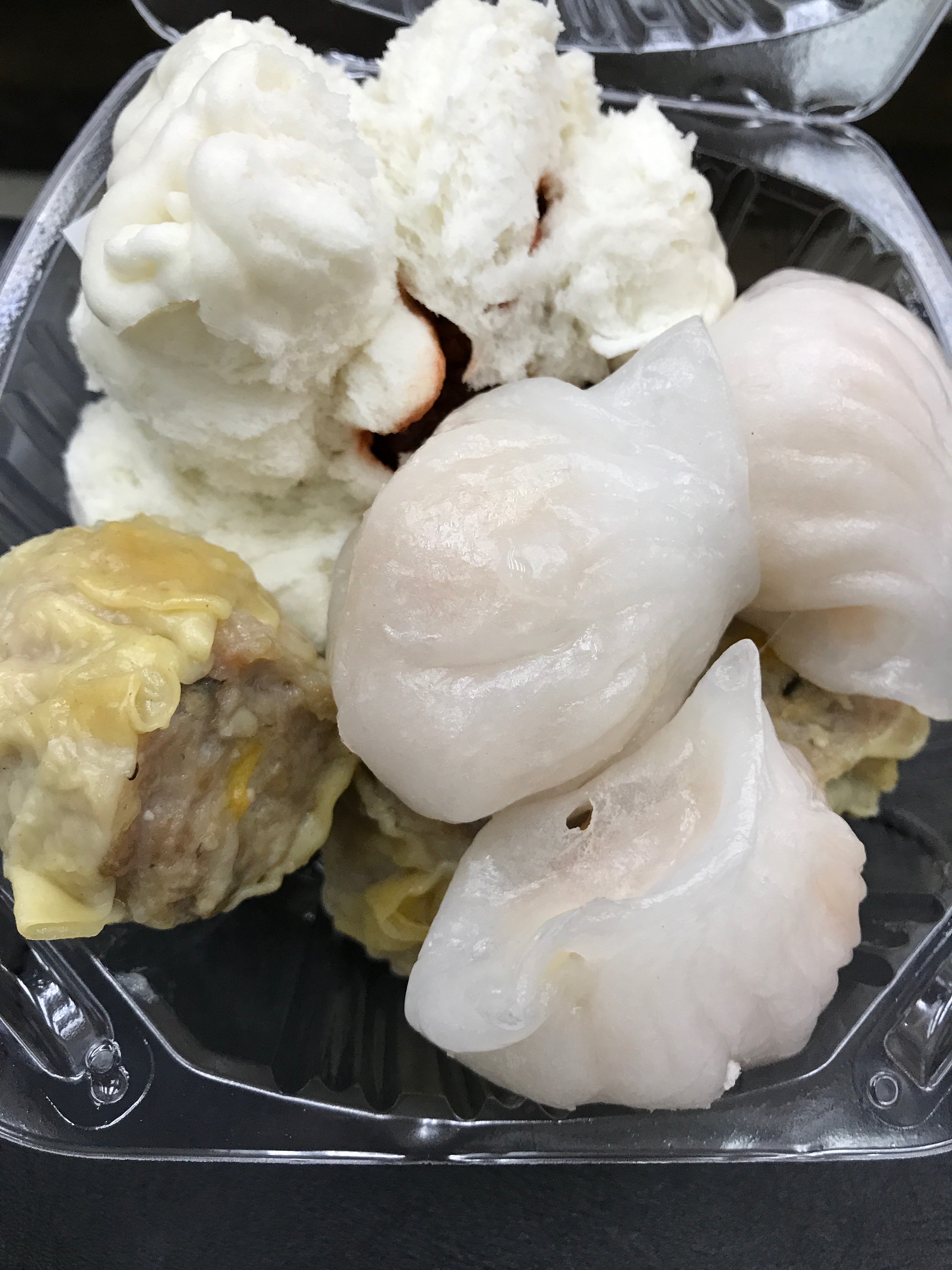One brisk autumn morning, we ventured out into Chinatown, located deep in the heart of San Francisco. Our mission was to find the best dim sum the community had to offer. We tried establishments crammed between markets and souvenir shops, restaurants with gold-plated columns and carpeted floors, and everywhere in between. How did each restaurant stack up?
First, we consulted local dim sum connoisseur Nevin Chin ‘20 to clarify the details of a dim sum excursion. Chin says, “Dim sum is a specific part of Chinese cuisine that’s mostly from the Southern Chinese province Guangdong, and traditionally comes in small dishes such as buns or dumplings. Eating dim sum is an important social gathering of family and friends. Traditionally, dim sum is served by waiters with carts of food, and one pays by the dish. e menu is a checklist of dishes served from the kitchen; these establishments are sit-down restaurants. There are also takeout restaurants that have food pre-made and people browse by looking through a glass behind the counter, then choosing specific dim sum they want to order. ere usually isn’t a lot of seating because most people take their food to go.”
We critiqued four restaurants based on five qualities: the quantity of dim sum and its taste and price, also noting the restaurant’s health rating and atmosphere. We ordered the same combination of dim sum at every restaurant: barbecue pork bun (cha siu bao), shrimp dumpling (har gow), and pork dumpling (shumai).

Our first stop was Wong Lee Bakery, a quaint and welcoming bakery on Jackson Street. Wong Lee Bakery’s interior design was clean, bright and simple. The bakery had layers upon layers of metal tins filled with dim sum. Even though the shop was busy, the servers were amiable and worked efficiently to attend to everyone’s needs. The health score was visibly displayed behind the counter: 84.
We ordered three pieces of har gow and siu mai and one cha siu bao for a total of $6.30. The cha siu bao’s bread to pork ratio was just right, with the moist, semi-sweet bread perfectly complementing the savory pork filling. While the siu mai was soggy, its warmth lent itself to a fresher, so er taste of the sumptuous pork dumpling. The har gow, however, was pulpy with a bland wrapping and subdued flavor; it was the undisputed letdown of the batch.
Next, we travelled to Stockton Street to visit Wing Sing Dim Sum, a bustling takeout shop. At 11:30 A.M., the narrow, no-nonsense business was extremely busy with a line out the door and a plethora of food behind the glass panel. The servers rudely ignored any patron who didn’t wave their money in the air and lacked an organized method of taking orders. Unsurprisingly, the health rating was nowhere to be seen. Yelp tells us, however, that Wing Sing earned a panic-inducing 64 and that it was in the bottom five percent of scored local restaurants.
For $5.53 we again ordered three pieces of har gow and siu mai and one cha siu bao. The price was not the letdown, though. The siu mai, while large, was absolutely repulsive; not an ounce of taste was to be found in the mushy displeasure, any sense of satisfaction replaced by a surplus of oil and grease. The har gow was similarly slippery with oil and revoltingly sloppy, the skin a displeasing starchy texture. Though the cha siu bao’s bread to meat ratio was satisfactory, the bun’s dry insipidness and the flavorless meat could not save the doughy disappointment. Overall, Wing Sing Dim Sum was inadequate.
Afterwards, we tried Good Mong Kok Bakery, a small, gloomy shop with a line out the door. We took our place in line and waited a good 30 minutes before stepping through the door. The interior of the bakery was depressing, with its monotone gray walls adorned only with cardboard boxes and rugged bags of rice strewn about. The servers were tolerable, working diligently but not making any effort to show noticeable hospitality. The health rating was not visible as the walls were covered with receipts, but Yelp reports a health rating of 78.
We were unable to order cha siu bao, as by the time we reached the counter Good Mong Kok had run out of the meaty buns. Thus, we purchased the three pieces of har gow and siu mai along with a boluo mianbao (pineapple bun) for an extra $1. The total cost was $5.80.
The har gow was satisfying, even if the shrimp was a tad mushy. The siu mai was also good, with fresh-tasting meat and wrapping to spare. Our pineapple bun had a subtle sweetness and a golden bready center with a crisp crust of sugary goodness, a solid substitute for cha siu bao.
Our last stop was Great Eastern Restaurant, known for being former president Barack Obama’s choice San Francisco dim sum restaurant. We entered the sit-down restaurant to full tables and a crowd of tourists already waiting. The ambiance of the two-story restaurant was bright and welcoming, with extravagant crystal chandeliers, plush white tablecloth tables, and traditional artwork on the walls. Despite the bustling atmosphere, the workers moved at a quick pace to get orders out to the tables. The health rating was a 72 for several violations of sanitation codes, a slightly concerning thought.

The menu was diverse, ranging from small side dishes to larger entrees. We ordered the shrimp dumplings and barbecue pork buns, the orders coming with three dumplings or buns in each. Out of curiosity, we also ordered shrimp rice rolls (har cheung), sticky rice (lo mai gai) and egg rolls (dan juan). The har gow was our favorite with its thin rice wrapping enveloping fresh shrimp with minced garlic and pepper seasoning. The cha siu bao’s fluffy, moist bread accompanied the seasoned pork perfectly. The shrimp rice rolls were drizzled with vinegar sauce over a chewy noodle wrap surrounding the tender shrimp, and the sticky rice came in leaf-wrapped packages encasing the starchy delight of meat and mushrooms. The egg rolls were crispy and golden brown and contained a savory shredded-vegetable filling. Our bill was $28.60, pricy compared to the other shops but logical for a fancier, sit-down restaurant. We enjoyed Great Eastern’s food overall and definitely recommend stopping by.
While all of the dim sum restaurants were satisfactory in their own right, we had more pleasant experiences in some compared to others. We compiled our scores for each shop, rating each based on dim sum, presentation, and price value on a scale of 0 – 5.
Overall, we were fairly pleased with our Chinatown dim sum excursion. While we believe there are other neighborhoods in San Francisco with superior dim sum, such as the Inner Sunset and Clement Street, Chinatown is a still a popular option for a quick authentic Chinese meal.

We would like to thank Jen Yeo ’18 for assisting us in eating and reviewing dim sum.






